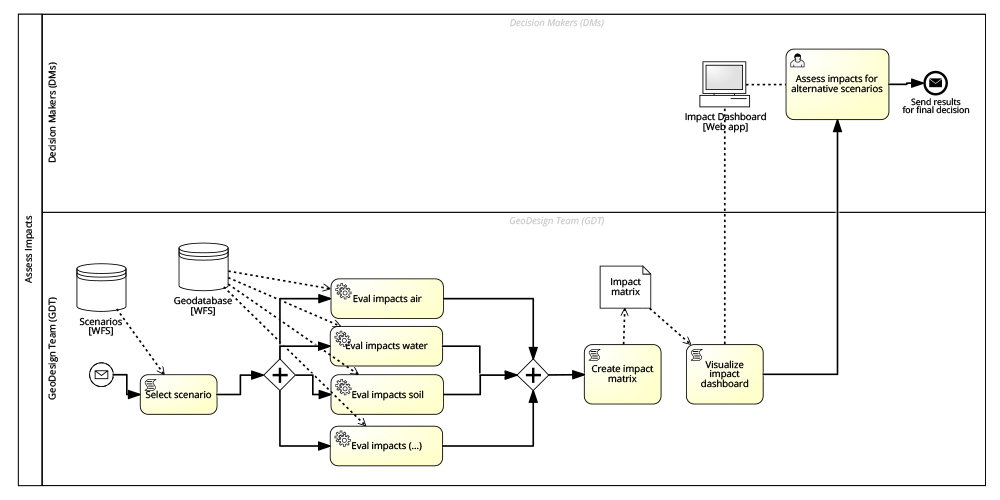Exploring the architecture of Geodesign as a process
Downloads
DOI:
https://doi.org/10.7480/rius.4.819Abstract
This paper explores the perspective of geodesign as a process. As such, it is argued methods and tools are needed to manage the process complexity, including the definition of the involved parties, of their roles and responsibilities, as well as all the steps to be undertaken to unfold the process, together with their underlying methods and enabling technologies and tools. A metaplanning operational approach based on Business Process Management is proposed to deal with the process complexity and eventually as a means to support the construction of a second generation of process-oriented Planning Support Systems. The overall discussion is supported by practical examples aiming at demonstrating how the Business Process Modelling and Notation language can be used to represent the planning processes from high level overview models to detailed ones which can express geodesign methods and enabling technologies.
How to Cite
Published
Issue
Section
License
Copyright (c) 2016 Michele Campagna

This work is licensed under a Creative Commons Attribution 4.0 International License.
References
Allen, E. (2001). INDEX: software for community indicators. In R. K. Brail, & R. E. Klosterman (eds.). Planning Support Systems: Integrating Geographic Information Systems, Models and Visualization Tools (pp. 229-261). Redlands, CA: ESRI, Inc.
Bhargava, H.K, Krishnan, H. & Muller, R. (1997). Decision Support on Demand: Emerging Electronic Markets for Decision Technologies. Decision Support Systems 19.3: 193–214.
Campagna, M., Ivanov, K., & Massa, P. (2014a, June). Orchestrating the spatial planning process: from Business Process Management to 2nd generation Planning Support Systems. In: Proceedings of the 17th AGILE Conference on Geographic Information Science, Connecting a Digital Europe through Location and Place. Castellón, Spain.
Campagna, M., Ivanov, K., & Massa, P. (2014b). Implementing metaplanning with Business Process Management. Procedia Environmental Sciences, 22, pp. 199-209.
Champlin, C., Hartmann, T. & Dewulf, G. (2014). Negotiating PSSs as Epistemological Objects: An exercise in sociotechnical model development for planning support. Manchester, UK. Retrieved from www.revitaplan.com/preview/31
DeBettencourt, J. S., Mandell, M. B., Polzin, S. E., Sauter, V. L , & Schofer, J. L. (1982). Making planning more responsive to its users: the concept of metaplanning. Environment and Planning A, 14(3), 311-322.
Emshoff, J. R. (1978). Planning the process of improving the planning process: A case study in meta-planning. Management Science, 24(11), 1095-1108.
Hall, P. (2002). Urban and Regional Planning. London: Routledge (fourth ed.).
Harris, B. (1989). Beyond geographic information systems: Computers and the planning professional. Journal of the American Planning Association, 55, 85-90.
Healey, P. (1993). The communicative turn in planning theory and its implications for strategy formation. In F. Fisher, & J. Forester (eds.), The Argumentative Turn in Policy Analysis and Planning (pp. 233-253). Durham, NC: Duke University Press.
Innes, J. E. (1996). Planning Through Consensus Building: A New View of the Comprehensive Planning Ideal. Journal of the American Planning Association, 62(4), 460-472.
Khakee, A. (1998). Evaluation and planning: inseparable concepts. Town Planning Review, 69(4), 359-374.
Klosterman, R. E. (1999). The What if? Collaborative planning support system. Environment and Planning B: Planning and Design, 26(3), 393-408.
Kwartler, M., & Bernard, R. (2001). CommunityViz: an integrated planning support system. In R. K. Brail, & R. E. Klosterman (Eds.). Planning Support Systems: Integrating Geographic Information Systems, Models and Visualization Tools (pp. 285-308). Redlands, CA: ESRI, Inc.
McLoughlin, J. B. (1969). Urban and Regional Planning: a Systems Approach. London, United Kingdom: Faber.
Steinitz, C. (2012) A framework for Geodesign. Redlands, CA: ESRI, Inc.
Weske, M. (2012) Business Process Management: Concepts, Languages, Architectures. Berlin/Heidelberg: Springer-Verlag.




